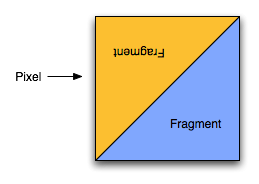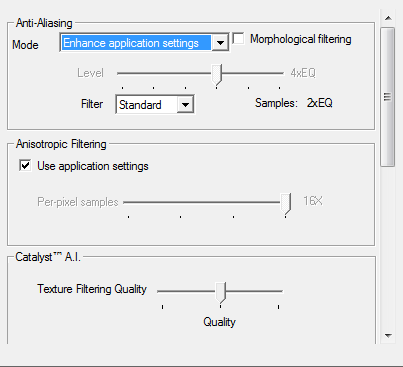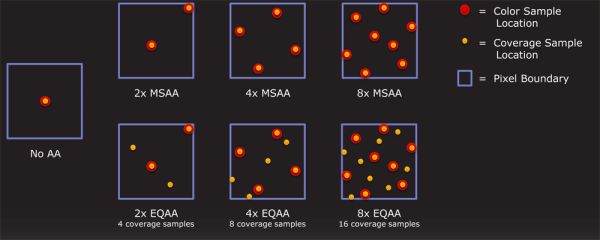AMD's Radeon HD 6970 & Radeon HD 6950: Paving The Future For AMD
by Ryan Smith on December 15, 2010 12:01 AM ESTAnother New Anti-Aliasing Mode: Enhanced Quality AA
With the 6800 series AMD introduced Morphological Anti-Aliasing (MLAA), a low-complexity post-processing anti-aliasing filter. As a post-processing filter it worked with a wide variety of games and APIs, and in most cases the performance overhead was not very severe. However it’s not the only new anti-aliasing mode that AMD has been working on.
New with the 6900 series is a mode AMD is calling Enhanced Quality Anti-Aliasing. If you recall NVIDIA’s Coverage Sample Anti-Aliasing (CSAA) introduced with the GeForce 8800GTX, then all of this should sound quite familiar – in fact it’s basically the same thing.
Under traditional MSAA, for a pixel covered by 2 or more triangles/fragments, 2, 4, or 8 subpixel samples are taken to determine what the final pixel should be. In the process the color of the triangle and the Z/depth of the triangle are both sampled and stored, and at the end of the process the results are blended together to determine the final pixel value. This process works well for resolving aliasing along polygon edges at a fraction of the cost of true super sampling, but it’s still expensive. Collecting and storing the Z and color values requires extra memory to store the values and extra memory bandwidth to work with the values. Ultimately while we need enough samples to determine colors of the involved triangles, we do not always need a great deal of them. With a few color/Z samples we have all of the color data we need in most cases, however the “hard” part of anti-aliasing becomes what the proper blending of color values should be.

1 Pixel Covred by 2 Triangles/Fragments
Thus we have EQAA, a compromise on the idea. Color/Z samples are expensive, but just checking if a triangle covers part of a subpixel is very cheap. If we have enough color/Z samples to get the necessary color information, then just doing additional simple subpixel coverage checks would allow us better determine what percentage of a pixel is covered by a given polygon, which we can then use to blend colors in a more accurate fashion. For example with 4x MSAA we can only determine if a pixel is 0/25/50/75/100 percent covered by a triangle, but with 4x EQAA where we take 4 color samples and then 4 additional coverage-only samples, we can determine blending values down to 0/12/25/37/50/62/75/87/100 percent coverage, the same amount of accuracy as using 8x MSAA. Thus in the right situation we can have quality similar to 8x MSAA for only a little over 4x MSAA’s cost.
In reality of course this doesn’t always work out as well. The best case scenario is that the additional coverage samples are almost as good as having additional color/Z samples, while the worst case scenario is that additional coverage samples are practically worthless. This depends on a game-by-game, if not pixel-by-pixel basis. In practice additional coverage samples are a way to slightly improve MSAA quality for a very, very low cost.
While NVIDIA has had the ability to take separate coverage samples since G80, AMD has not had this ability until now. With the 6900 hardware their ROPs finally gain this ability.
Beyond that, AMD and NVIDIA’s implementations are nearly identical except for the naming convention. Both can take a number of coverage samples independent of the color/Z samples based on the setting used; the only notable difference we’re aware of is that like AMD’s other AA modes, their EQAA mode can be programmed to use a custom sample pattern.
As is the case with NVIDIA’s CSAA, AMD’s EQAA mode is available to DirectX applications or can be forced through the drivers. DirectX applications can set it through the Multisample Quality attribute, which is usually abstracted to list the vendor’s name for the mode in a game’s UI. Otherwise it can be forced via the Catalyst Control Center, either by forcing an AA mode, or as is the case with NVIDIA, enhancing the AA mode by letting the game set the AA mode while the driver overrides the game and specifies different Multisample Quality attribute. Thus the “enhance application settings” AA mode is new to AMD with the 6900 series.

To be honest we’re a bit ruffled by the naming choice. True, NVIDIA did go and have to pick daft names for their CSAA modes (when is 8x not 8 sample MSAA?), but ultimately CSAA and EQAA are virtually identical. NVIDIA has a 4 year lead on AMD here, and we’d just as well use NVIDIA’s naming conventions for consistency. Instead we have the following.
| Coverage Sampling Modes: CSAA vs EQAA | ||||
| NVIDIA |
Mode (Color + Coverage) |
AMD | ||
| 2x | 2+0 | 2x | ||
| N/A | 2+2 | 2xEQ | ||
| 4x | 4+0 | 4x | ||
| 8x | 4+4 | 4xEQ | ||
| 16x | 4+12 | N/A | ||
| 8xQ | 8+0 | 8x | ||
| 16xQ | 8+8 | 8xEQ | ||
| 32x | 8+24 | N/A | ||
AMD ends up having 1 mode NVIDIA doesn’t, 2xEQ, which is 2x MSAA + 2x cover samples; meanwhile NVIDIA has 16x (4x MSAA + 12 cover samples) and 32x (8x MSAA + 24 cover samples). Finally, as we’ll see, just as is the case for NVIDIA additional coverage samples are equally cheap for AMD.











168 Comments
View All Comments
DoktorSleepless - Wednesday, December 15, 2010 - link
What benchmark or game is used to measure noise?Hrel - Wednesday, December 15, 2010 - link
I'm not 100% but I believe they test it under Crysis. It was either that or a benchmark that put full load on the system. It was in an article in last year or 2, I've been reading so long it's all starting to mesh together; chronologically. But suffice it to say it stresses the system.Hrel - Wednesday, December 15, 2010 - link
It's furmark, it's in the article.Adul - Wednesday, December 15, 2010 - link
nice Christmas gift from the GF :DAstroGuardian - Wednesday, December 15, 2010 - link
I saw my GF buying a couple of those. One is supposed to be for me and she doesn't play games...... WTF?MeanBruce - Wednesday, December 15, 2010 - link
Wow, you are getting a couple of 6950s? All I am getting from my 22yo gf is a couple of size F yammos lying on a long narrow torso, and a single ASUS 6850. Don't know which I like better, hmmmmm. Wednesday morning comic relief.Adul - Wednesday, December 15, 2010 - link
damn sounds good to me :) enjoy both ;)SirGCal - Wednesday, December 15, 2010 - link
I'm happy to see these power values! I did expect a bit more performance but once I get one, I'll benchmark it myself. By then the drivers will likely have changed the situation. Now to get Santa my wish list... :-) If it was only that easy...mac2j - Wednesday, December 15, 2010 - link
One of the most impressive elements here is that you can get 2x6950 for ~$100 more than a single 580. That's some incredible performance for $600 which is not unheard of as the price point for a top single-slot card.Second... the scaling of the 6950 combined with the somwhat lower power consumption relative to the 570 bodes well for AMD with the 6990. My guess is they can deliver a top performing dual-GPU card with under a 425-watt TDP .... the 570 is a great single chip performer but getting it into a dual-gpu card under 450-500w is going to be a real challenge.
Anyway exciting stuff all-around - there will be a lot of heavy-hitting GPU options available for really very fair prices....
StormyParis - Wednesday, December 15, 2010 - link
It's nice to have all current cards listed, and helps determine which one to buy. My question, and the one people ask me, is rather "is it worth upgrading now". Which depends on a lot of things (CPU, RAM...), but, above all, on comparative perf between current cards and cards 1-2-3 generations out. I currently use a 4850. How much faster would a 6850 or 6950 be ?